Peter Brown in the media
Family affair more than sum of parts
The Gisborne Herald, October 15, 2015
by Kristine Walsh
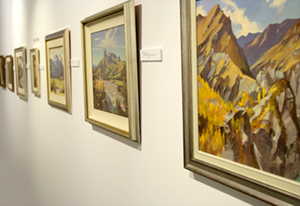 An exhibition as much about their differences as their similarities.
An exhibition as much about their differences as their similarities.
IT has been 10 years almost to the day since Gisborne artist Peter Brown died, but you’d hardly know it. Once member of a family of four, Brown’s work takes up a full quarter of wall-space in the newly-hung exhibition by the family Brown.
“We were asked if we would exhibit and thought that was a lovely idea,” says the late Brown’s wife, Catherine Brown. “It just seemed natural to have Peter represented with his work as well.”
While Relativity is a family affair, Catherine Brown, son Romilly Brown and daughter Cat Brown say it is as much about their differences as it is about their similarities.
“It is certainly about us as a creative family . . . growing up, Cat and Romilly were always drawing because that’s just what we did,” Catherine Brown says.
“But it’s also a way to highlight our individualism,” adds Cat Brown. “We all have different styles and different outlooks and that’s what is seen here.”
Between them the trio trawled their collections for the dozen Peter Brown paintings they have chosen to show, ranging from a pencil drawing done at Elam School of Fine Arts in the 1950s to a scenic oil painted around 2000. Particularly special to “the kids” are two still lifes, each gifted to the younger Browns on their 21st birthdays.
For her part Catherine Brown — who met her late husband at a painting class in Hawke’s Bay — says the approaching exhibition spurred her into creating a new collection of 20 works from the domestic (“things I find around the kitchen”) to land- and street-scapes, some from sketches made in Sydney earlier this year.
On the opposite wall, Romilly Brown has drawn from his fascination with fantasy worlds in creating a quartet of richly-toned small oils; four more delicate pen-and-wash images featuring his favoured character, the rat; and a stand-alone piece depicting a monster emerging from a fractious sea.
The piece de resistance
His piece de resistance, however, is an installation of one of his favourite board games, Robinson Crusoe: Adventures On The Cursed Island.
“When I got the game it came with all these plastic pieces that just weren’t that nice to play with,” he says. “So I decided to sculpt my own.”
Each clay polymer piece is an artwork in itself — tiny pieces of fruit, skulls and other human bones, hunks of meat, the works. Romilly Brown has made hundreds of them and they are so unique that he sells them to other board game addicts around the world.
“It does take ages, you need an incredible amount of focus,” he says. “But it helps me fund my own game addiction.”
Finally, there’s a large collection of 14 works from Cat Brown, progressing from monochromatic tumbling waves at her “happy place” (Wainui) through portraits of her “other art family” (Grace Jones, Frida Kahlo and David Hockney) to wildly-coloured works inspired by the vibrancy of Samoa.
Though best known as a photographer, Balkwill-Brown has exhibited paintings in the past (in Sydney) and is currently focused full-time on painting.
“I have always painted and always wanted to be an artist but had let the pressure of professional commitments get in the way,” she says.
“After turning 40 earlier this year I thought it was time to do what I’d always wanted to and I’ve never been happier.”
Between them, members of the family Brown have created a huge show for Tairawhiti Museum’s White Gallery — more than 50 pieces in total — that is more than a sum of its parts.
“I guess if we were a musical family we’d be making music,” Catherine Brown says. “This is just what we do.”
Relativity is running at the Tairawhiti Museum from the 17th October - 6th December 2015.
Gisborne artist’s painting now in Scottish gallery
The Gisborne Herald, Saturday, September 30, 2006
by Kristine Walsh
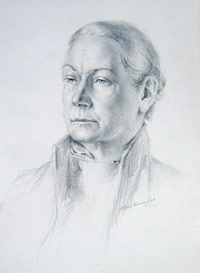 THE Scottish National Portrait Gallery now has in its possession a well-travelled image of one of Scotland’s most important artists, Anne Redpath (1895-1965), and it is all thanks to a Gisborne artist and his family.
THE Scottish National Portrait Gallery now has in its possession a well-travelled image of one of Scotland’s most important artists, Anne Redpath (1895-1965), and it is all thanks to a Gisborne artist and his family.
Peter Brown spent time in Britain during the late 1950s and early 1960s, during that time creating the Redpath pencil portrait for exhibition in a 1960 Royal Scottish Academy show.
After a long and prolific career, Brown died in Gisborne last year and since then his wife Catherine has been charged with caring for his archives.
Coming across the Redpath portrait, she decided to offer it to the Scottish National Portrait Gallery.
The reply was prompt: Senior curator Julie Lawson said the gallery would be "absolutely delighted to accept the drawing".
Pleased, also, was gallery director James Holloway. "Anne Redpath’s stature as an artist grows every year and I, personally, am delighted to have your drawing in our permanent collection," he said.
Peter Brown died in October, 2005 at the age of 84. The most recent exhibition of his work was a retrospective held at Paraparaumu gallery McGregor Wright in May/June this year.
Media Release - November 2005
Charles Fredrick (Peter) Brown
New Zealand Artist
1921 - 2005
One of New Zealand’s finest exponents of traditional realism has passed away.
Artist Peter Brown who, on winning the 1972 NZ Kelleher Prize, was named by Sir William Dargie as this country’s best living landscape artist passed away in October leaving a legacy of over 2000 paintings held by collectors worldwide.
Charles Fredrick Peter Brown (known to family and friends and members of the art world as Peter) had a formidable record of achievement and painted right up until a few months before his death at age 84.
The collected works
Brown’s works are held in many in public and private collections through New Zealand and the world and he exhibited with:
- The Royal Scottish Academy (Scotland)
- The Royal Society of Portrait Artists (UK)
- The Rutland Group (New Zealand)
- The New Group (New Zealand)
- The American Watercolour Society (USA)
- The Chelsea Art Society (UK)
- Army Art Society (UK)
The beginnings of an artist
Born in Dunedin and raised both there and in Auckland, Brown’s life as an artist began during his time as a prisoner of war during WWII when he made a promise to himself - if he made it out alive, he would dedicate the rest of his life to his great passion – art.
Following a daring breakout from the camp he made his way to England, and when the end of the war was declared he made his way back to NZ where he made true his promise and began his studies at the Elam School of Fine Art.
His talent shone so brightly, that after just two years as a student he was invited onto the teaching staff - where he stayed in a position as Fine Arts lecturer for over ten years.
During this tenure Brown joined the ‘Rutland Group’ of painters – who were considered radicals of the time – and who were recently commemorated in a special retrospective exhibition and limited edition book titled We Learned to See written by historians Rie Fletcher and Ian Thwaites.
His art captured international attention in the 50s and he was invited to attend the Slade School of Art in London where he studied and exhibited further, and where his art caught the attention of the distinguished English artist Augustus John, who became a mentor to the younger artist.
Returning to NZ Brown continued to teach and paint as Artist in Residence for the Hawkes Bay Art Society. While in Napier, he married Catherine Brown and the couple moved to Gisborne – the city that became his painting base for the remainder of his life.
Passing on the Passion
During his life Brown influenced 1000s of artists and students – both at Elam, Auckland; at the Napier Art Centre, in Gisborne, and during private classes.
Former NZ Army Artist and former student Ion Brown (no relation) described Peter Brown as:
“A man who did not suffer fools well, but a man who, if he spotted talent would devote all the time he could to ensure it blossomed.”
The artworks
Brown loved the New Zealand landscape and spent his life capturing it in all its depths and beauty.
He also travelled widely throughout Italy, Spain and Morocco in search of new and interesting subjects.
During his life still life, flowers and portraits emerged to national and critical acclaim – with the portrait his true favourite form.
He would say:
“You have to spend days with a subject to get it just right – and that is a lot to ask of someone – but still, portraits have always been my first love.”
Peter Brown is survived by his wife Catherine Brown, son Romilly Brown and daughter Cat Brown.
Obituary
Gisborne Herald , October 2005 ONE of Gisborne's most prolific artists has died, leaving a legacy of an estimated 2000 paintings held by collectors around New Zealand and the world.
Just 14 months ago Charles Frederick Peter (Peter) Brown and his wife Catherine were celebrating his reprieve from the illness that had dogged him in recent years.
At the time he told The Gisborne Herald that, with better health, he was looking forward to getting back into painting as well as life's other pleasures, like the horseshoe pitching game he had previously enjoyed on a weekly basis.
But in recent months he was again fighting the illness that eventually took his life.
While he was unwell, however, his artwork was still out in the world.
His dealer, the Kapiti Coast-based McGregor Wright Gallery, is this month celebrating its 126th birthday with an exhibition of works by 10 of its most high-profile artists, including seven pieces by Peter Brown.
In June Brown contributed eight paintings to the biennial Chelsea Art Exhibition in Gisborne, most of which sold during the two-day exhibition period.
Two years ago Brown's work was an important part of an Auckland exhibition of works by surviving members of “radical arts collective” the Rutland Group, made up largely of graduates of the Elam School of Art who met regularly from 1935 to 1958.
And he again featured large in a limited edition history of the Rutland Group, published last year by Auckland Museum historians.
Brown had already had an interesting life before he moved to Gisborne from Hawke's Bay more than quarter of a century ago.
Thirty-five years earlier, in 1943, Royal Air Force navigator Peter Brown, aged just 22, was shot down over Holland and bundled off to a German prisoner of war camp where he spent the last two years of the Second World War.
Before his escape Brown decided that, if he became a free man again, he would dedicate the rest of his life to working as an artist.
He did.
Images from scenes of Sydney bays to South Island rivers typified Brown's work and had been in demand since his McGregor Wright dealer, Gordon Cooksley, first urged him to join his stable of artists more than 30 years ago.
Since his illness, though, the artist got “a little more self-indulgent” by spending more time on his first love -- portraiture.
“You sometimes have to spend days with a subject to get it just right, which is a lot to ask of someone,” he told The Gisborne Herald last year. “Still, portraits have always been my first love.”
At the time he admitted that his output would be down from the 30-to-40 paintings he had produced every year since he graduated from Elam six decades earlier.
That, he said, was partly down to the passage of time, partly because he gave each painting more consideration, and partly because of the effects of his illness.
Catherine Brown said that, since then, her husband had produced a number of paintings, as well as enjoying other pleasures of life.
“He had a few very good months,” she said.
Peter Brown, 84, died at his Whataupoko home on 14 October and is survived by his wife, Catherine, his two adult children, Romilly and Catriona, and his granddaughter, Penelope.
- by Kristine Walsh
Art supports a worthy cause
The Gisborne Herald, Saturday, June 4, 2005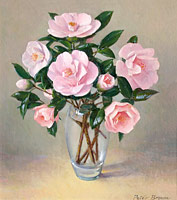 COPPER sculptures, contemporary jewellery and photography are just a few of the artistic mediums that will feature in the Chelsea Art Exhibition next weekend. COPPER sculptures, contemporary jewellery and photography are just a few of the artistic mediums that will feature in the Chelsea Art Exhibition next weekend.The biennial exhibition, organised by Friends of Chelsea, gives Gisborne artists the opportunity to show their work collectively and support a worthy cause. The contributing artists will donate 30% of the proceeds of any pieces sold to Chelsea Hospital's respite care service. Friends of Chelsea chairwoman Anne Gordon said the respite care service survived entirely on fundraising projects. "We are so grateful to the artists who have kindly donated their work. It would not be possible without them," she said. |
The Gisborne community had been extremely supportive of the past three Chelsea Art Exhibitions, Mrs Gordon said, and she hoped for a similar response this time around. Featuring artists are Peter Brown, Gavin Smith, Adrian Cave, Roger Shanks, Christina King, Mary Briant, Peggy Ericson, Anne Alderlieste, Harriet Sherriff, Kate Hathaway, Tessa Chrisp, Erika Holden, Ro Timms, Glenda Gibbs, Elm Thorpe and Helena Andersson. Their works cover a range of mediums including oil paint, watercolours, photography, stainless steel and copper sculpture, mosaic mirrors, earthenware clay wallhangings and contemporary jewellery. The exhibition will be at Lawson Field Theatre. An opening night, with refreshments and nibbles, will be held on Friday June 10, starting at 5.30pm. Tickets are $15 and are available from Chelsea Hospital or And gift shop on Gladstone Road. The exhibition will also be open to the public on June 11 and 12, between 10am and 4pm, with a $5 entry fee. |
Rutland times revisited
New Zealand Herald, Wednesday, December 8, 2004The weather was squally on Saturday, but that didn’t dampen the celebratory mood of 150 people at a book launch. The launch of We Learnt To See: Elam’s Rutland Group 1935–58 is the culmination of a weighty project by former Auckland Museum Research librarians Ian Thwaites and Rie Fletcher, and it is completely sold out.
Two years ago, Thwaites and Fletcher put together the earlier stages of their project, Rutland Group Revisited, an exhibition at Kinder House of works by the group, named after the Rutland St. building which housed the original Elam Art School.
The group was created at the behest of Elam director A.J.C. Fisher, with the aim of raising the standard of art in Auckland. Up to 35 former students met monthly to appraise each other’s work and it is considered a significant period in the city’s art history.
For the past two years, Thwaites and Fletcher have been tracking down names, checking records and interviewing group members.
Without any funding, they have self-published We Learnt To See with 162 copies at $120 each pre-sold to members of the group, their families and some institutions such as public libraries.
The book covers the Rutland Group and 350 associated artists, reviewers, dealers and art historians, as well as substantial biographical essays and a review of other art groups active during approximately the same period.
Saturday’s launch at St. John’s School in Meadowbank included a walk to the graveside of Dr. John Elam, who founded – with a £10,000 bequest – what is now Auckland University’s School of Fine Arts.
Rutland Group supporters, Elam head professor Michael Dunn and artist Don Binney spoke of what it was like to work at Elam and told anecdotes about some of the featured artists.
The oldest Rutlander present, 96-year-old Ruth Coyle made it to the graveside. “Don likened (Dr. Elam’s bequest) to a tree with strong roots suggesting good leaves and fruit,” said Fletcher.
- Linda Herrick
Cancer can't quiet artist's calling
The Gisborne Herald, Thursday, August 19, 2004SIXTY years ago Royal Air Force navigator Peter Brown, aged just 22, was shot down over Holland and bundled off to a German prisoner of war camp where he spent the last two years of the Second World War.
Before his escape, Brown decided if he became a free man again he would dedicate the rest of his life to working as an artist.
He did.
But even life as an artist, living in a leafy Gisborne suburb and watching his children grow into adulthood, has not been without its dangers. Brown, now 83, has just emerged from a tussle with cancer that nearly finished what the war began.
Asked what he wants to do as his health slowly improves, Brown echoes the thought that drove him all those decades ago. He wants to get back into his art.
And there is plenty of demand for it.
Brown's work was last year an important part of an Auckland exhibition of works by surviving members of the Rutland Group - what has been described as a "radical" artists' collective - made up largely of graduates of the Elam School of Art who met regularly from 1935 to 1958.
He will again feature large in a limited edition history of the Rutland Group, soon to be published by Auckland Museum historians.
And he is this month showing work in a group show celebrating the 125th birthday of his long-time dealer, Wellington's McGregor Wright Art Gallery.
Showing alongside 14 other McGregor Wright artists, Brown has five recent paintings in the exhibition, which opened on August 8.
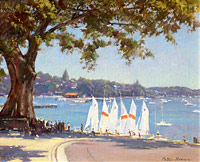 Exhibiting the realism typical of his work, the pieces include a vibrant summer scene of Sydney's Watsons Bay - captured when he recently visited his daughter in Australia -- a South Island vista along the autumn-clad Clutha River, and still lifes including a pretty depiction of lilacs, plus a work bursting with the aroma of plump, ripe peaches.
Exhibiting the realism typical of his work, the pieces include a vibrant summer scene of Sydney's Watsons Bay - captured when he recently visited his daughter in Australia -- a South Island vista along the autumn-clad Clutha River, and still lifes including a pretty depiction of lilacs, plus a work bursting with the aroma of plump, ripe peaches.
Brown says these are the types of works that had been in demand since his McGregor Wright dealer, Gordon Cooksley, first urged him to join his stable of artists some 30 years ago.
Since his illness, though, he says he may get a little more self-indulgent by spending more time on his first love - portraiture.
"You sometimes have to spend days with a subject to get it just right, which is a lot of ask of someone," he says. "Still, portraits have always been my first love."
That is clear from the display of paintings and conte works positioned throughout the Whataupoko villa he and wife Catherine have occupied in the nearly 25 years since they moved to Gisborne from Hawke's Bay.
Most are portraits.
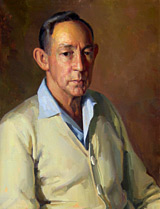 And most striking is the familial similarities in the works. The artist's own self-portrait mirrors a 1960s image he painted of his late father. A conte drawing of Catherine as a younger woman is the spitting image of a portait of her mother, hanging on the opposite wall.
And most striking is the familial similarities in the works. The artist's own self-portrait mirrors a 1960s image he painted of his late father. A conte drawing of Catherine as a younger woman is the spitting image of a portait of her mother, hanging on the opposite wall.
Whatever he creates he admits his output - like editions of the Rutland book which celebrates the group members' assertion that "without drawing, there is no art" - will be limited.
In the nearly six decades since he graduated from Elam he has traditionally produced 30-to-40 paintings a year. Now, he says, he would be more than happy to put out a dozen.
That, he says, is partly down to the passage of time, partly because he gives each painting more consideration, and partly because he is still suffering the effects of the cancer that nearly put paid to his career.
Meanwhile, behind Brown's vine-draped villa the huge garage that houses his studio is beckoning. And he is looking forward to getting back into life's other pleasures, like pitching horseshoes, a game that, until recent months, he enjoyed on a weekly basis.
Catherine Brown says she doesn't really care what he does. She just feels lucky she still has him.
- Kristine Walsh
